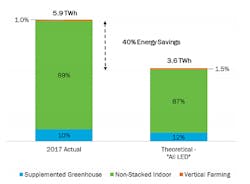SSL delivers energy savings in horticultural lighting applications
The US Department of Energy said that a complete switch to LED lighting for horticultural applications would deliver 3.6 TWh in energy savings or $240 million annually in the US.
The DOE has recently released a research report that contemplated how much energy could be saved annually were the horticultural industry to make a complete and immediate transition to LED-based SSL. The agency studied SSL deployment in supplemental greenhouse lighting; in ceiling-mounted, single-layer growing operations lit solely by electric light; and in emerging vertical farms where multiple layers of plants are lit with electric light. In aggregate, the report said an LED transition would deliver 40% savings, equating to $240 million per year.
Interested in articles & announcements on horticultural lighting?
The report “Energy savings potential of SSL in horticultural applications” followed the same formula that the DOE has used in theoretically projecting what an immediate and complete SSL transition could deliver in general lighting. The agency has released a report called “Adoption of LEDs in common lighting applications” at two-year intervals. The 2017 report projected potential savings of $44 billion per year if all lighting in the US were swapped to LEDs.
Clearly, the horticultural opportunity is not that large, although savings of 3.6 TWh per year would take a significant burden off the national power-generation burden. Moreover, population and the need for more food will only escalate.
The DOE said supplemental lighting is presently used in 26.8 million ft2 of greenhouse space. Non-stacked space lit artificially totals 18.7 million ft2. The nascent vertical farms market is only 0.5 million ft2 now but has tremendous potential for growth. According to the DOE, LEDs make up 2% and 4%, respectively, of the first two applications but 66% of the vertical farm application that really wasn’t feasible prior to LEDs (see chart above).
Indeed, as we have reported before, the exciting element to LED lighting used for horticulture comes from the new applications such as vertical farming and with changes to more efficient techniques in other applications. The evidence suggests that LEDs can deliver tunable light recipes that have the potential of increasing yields while saving energy.
We just published an article that covered some of the most compelling presentations from our US Horticultural Lighting Conference held in late 2017. And we are planning two such conferences for 2018. The Horticultural Lighting Conference Europe will be held May 14–15 in the Netherlands. The Horticultural Lighting Conference US will be held Oct. 9–10 in Portland, OR. You can follow all our horticultural lighting content at our dedicated microsite on the topic that is a companion to our main website.
Back to the DOE report, you can download the full report on the agency’s SSL website.

Maury Wright | Editor in Chief
Maury Wright is an electronics engineer turned technology journalist, who has focused specifically on the LED & Lighting industry for the past decade. Wright first wrote for LEDs Magazine as a contractor in 2010, and took over as Editor-in-Chief in 2012. He has broad experience in technology areas ranging from microprocessors to digital media to wireless networks that he gained over 30 years in the trade press. Wright has experience running global editorial operations, such as during his tenure as worldwide editorial director of EDN Magazine, and has been instrumental in launching publication websites going back to the earliest days of the Internet. Wright has won numerous industry awards, including multiple ASBPE national awards for B2B journalism excellence, and has received finalist recognition for LEDs Magazine in the FOLIO Eddie Awards. He received a BS in electrical engineering from Auburn University.





